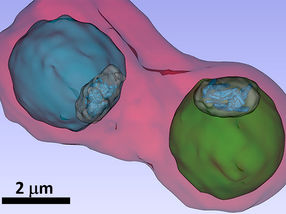Electrical control of single atom magnets
The energy needed to change the magnetic orientation of a single atom – which determines its magnetic stability and therefore its usefulness in a variety of future device applications – can be modified by varying the atom's electrical coupling to nearby metals.
This striking result was published in the journal Nature Nanotechnology by an international group of scientists.
Anyone playing with two magnets can experience how they repel or attract each other depending on the relative orientation of their magnetic poles. The fact that in a given magnet these poles lie along a specific direction rather than being randomly oriented is known as magnetic anisotropy, and this property is exploited in a variety of applications ranging from compass needles to hard drives.
"For 'large' pieces of magnetic material," emphasized Dr Joaquín Fernández-Rossier from the INL, "magnetic anisotropy is determined primarily by the shape of a magnet. The atoms that form the magnetic material are also magnetic themselves, and therefore have their own magnetic anisotropy. However, atoms are so small that it is hardly possible to ascribe a shape to them, and the magnetic anisotropy of an atom is typically controlled by the position and charge of the neighbouring atoms."
Using a scanning tunnelling microscope, an instrument capable of observing and manipulating an individual atom on a surface, LCN researchers and their colleagues discovered a new mechanism that controls magnetic anisotropy at the atomic scale.
In their experiment, the research team observed dramatic variations in the magnetic anisotropy of individual cobalt atoms depending on their location on a copper surface capped with an atomically-thin insulating layer of copper nitride.
These variations were correlated with large changes in the intensity of another phenomenon – the Kondo effect – that arises from electrical coupling between a magnetic atom and a nearby metal. With the help of theoretical and computational modelling performed in Germany and Portugal, the researchers found that, in addition to the conventional structural mechanisms, the electronic interactions between the metal substrate and the magnetic atom can also play a major role in determining magnetic anisotropy.
"Electrical control of a property that formerly could only be tuned through structural changes will enable significant new possibilities when designing the smallest possible devices for information processing, data storage, and sensing," said LCN researcher Dr Cyrus Hirjibehedin.
In contrast to the more conventional mechanisms, this contribution to the magnetic anisotropy can be tuned electrically using the same process that drives many transistors, the field effect. These results are particularly timely because they support efforts to find material systems with large magnetic anisotropy that are free of rare earth elements, scarce commodities whose mining has large environmental impact.
Most read news
Other news from the department science

Get the chemical industry in your inbox
By submitting this form you agree that LUMITOS AG will send you the newsletter(s) selected above by email. Your data will not be passed on to third parties. Your data will be stored and processed in accordance with our data protection regulations. LUMITOS may contact you by email for the purpose of advertising or market and opinion surveys. You can revoke your consent at any time without giving reasons to LUMITOS AG, Ernst-Augustin-Str. 2, 12489 Berlin, Germany or by e-mail at revoke@lumitos.com with effect for the future. In addition, each email contains a link to unsubscribe from the corresponding newsletter.














![[Fe]-hydrogenase catalysis visualized using para-hydrogen-enhanced nuclear magnetic resonance spectroscopy](https://img.chemie.de/Portal/News/675fd46b9b54f_sBuG8s4sS.png?tr=w-712,h-534,cm-extract,x-0,y-16:n-xl)









































